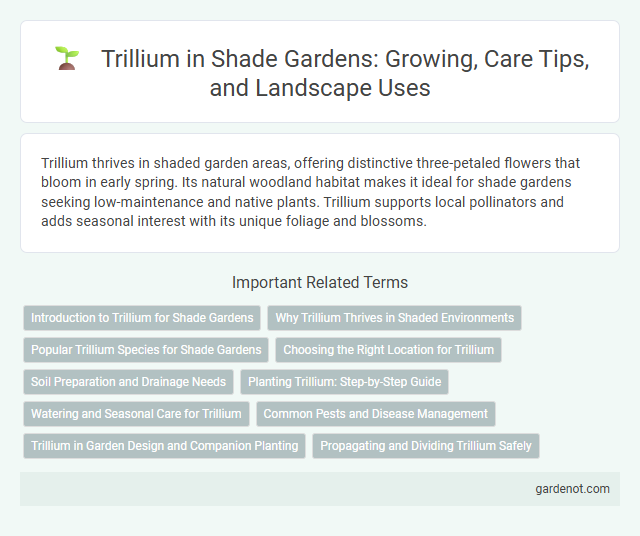Trillium thrives in shaded garden areas, offering distinctive three-petaled flowers that bloom in early spring. Its natural woodland habitat makes it ideal for shade gardens seeking low-maintenance and native plants. Trillium supports local pollinators and adds seasonal interest with its unique foliage and blossoms.
Introduction to Trillium for Shade Gardens
Trillium is a perennial wildflower well-suited for shade gardens due to its preference for rich, moist, and well-drained woodland soils. Known for its distinctive three-petaled blooms and broad, lobed leaves, Trillium adds early spring color and texture beneath deciduous trees. Its slow growth and low maintenance make it an ideal native plant for creating naturalistic shade garden landscapes.
Why Trillium Thrives in Shaded Environments
Trillium thrives in shaded environments due to its evolutionary adaptation to low-light conditions, allowing efficient photosynthesis under forest canopies. The plant's broad, three-petaled leaves maximize light capture while minimizing water loss, making it well-suited for moist, nutrient-rich soils often found in shaded gardens. Its growth cycle synchronizes with early spring when sunlight briefly reaches the forest floor, providing an optimal window for development before full canopy closure.
Popular Trillium Species for Shade Gardens
Trillium grandiflorum, known as the large-flowered trillium, is a popular choice for shade gardens due to its striking white blooms and adaptability to moist, well-drained soil. Trillium cernuum, the nodding trillium, offers delicate pink to white flowers that thrive in rich, shaded woodland environments, enhancing garden biodiversity. Trillium erectum, or red trillium, adds vibrant color with its deep red petals and prefers shaded, humus-rich areas, making it an excellent species for shaded garden beds.
Choosing the Right Location for Trillium
Trillium thrives best in shaded garden areas with rich, well-drained, and consistently moist soil enriched with organic matter like leaf mold or compost. Selecting a location under deciduous trees allows Trillium to benefit from spring sunlight before the canopy fills, optimizing its growth cycle. Avoiding overly wet or compacted soil conditions ensures healthy root development and vibrant blooms in this shade-loving perennial.
Soil Preparation and Drainage Needs
Trillium thrives in rich, well-draining soil enriched with organic matter such as leaf mold or compost to maintain consistent moisture without waterlogging. Ideal soil pH ranges from slightly acidic to neutral (6.0-7.0), promoting optimal nutrient uptake and healthy root development. Proper drainage prevents root rot and supports the plant's natural woodland habitat conditions, ensuring vigorous growth in shaded garden environments.
Planting Trillium: Step-by-Step Guide
Planting trillium requires selecting a shaded location with rich, well-drained soil high in organic matter to mimic its natural woodland habitat. Prepare the site by loosening the soil and incorporating leaf mold or compost to improve moisture retention and fertility. Plant rhizomes about 3 inches deep and 12 to 18 inches apart in early fall or late summer for optimal root establishment before winter dormancy.
Watering and Seasonal Care for Trillium
Trillium thrives in consistently moist, well-drained soil, requiring regular watering to prevent the soil from drying out, especially during dry spells in spring and summer. Applying a layer of organic mulch helps retain soil moisture and regulates temperature, crucial for Trillium's delicate root system. Seasonal care involves cutting back the foliage only after it has yellowed and died back naturally in late summer or fall to support healthy growth in the following season.
Common Pests and Disease Management
Trillium plants in shade gardens often face challenges from pests such as slugs, aphids, and spider mites, which can cause significant leaf damage and stunt growth. Effective management includes regular inspection, use of organic slug repellents, and applying insecticidal soap to control aphid and mite populations. Maintaining well-drained soil and proper spacing reduces fungal diseases like leaf spot and root rot, ensuring healthier Trillium growth.
Trillium in Garden Design and Companion Planting
Trillium, prized for its distinctive three-petaled flowers and lush foliage, adds a focal point of natural elegance in shade garden design, thriving best under deciduous trees where dappled sunlight filters through. Integrating Trillium with companion plants such as ferns, hostas, and wild ginger enhances biodiversity while creating layered textures and promoting healthy soil ecosystems. These shade-loving perennials complement Trillium by maintaining consistent moisture levels and providing seasonal interest, crucial for a balanced, visually captivating woodland garden environment.
Propagating and Dividing Trillium Safely
Propagating and dividing trillium requires careful timing during late summer to early fall when the plant is dormant, reducing stress and ensuring successful growth. Use a sharp, sterile knife to divide rhizomes, ensuring each section contains at least one healthy bud to promote robust new plants. Plant divisions immediately in well-draining, shaded soil rich in organic matter to mimic natural woodland conditions and encourage thriving trillium colonies.
Trillium Infographic

 gardenot.com
gardenot.com